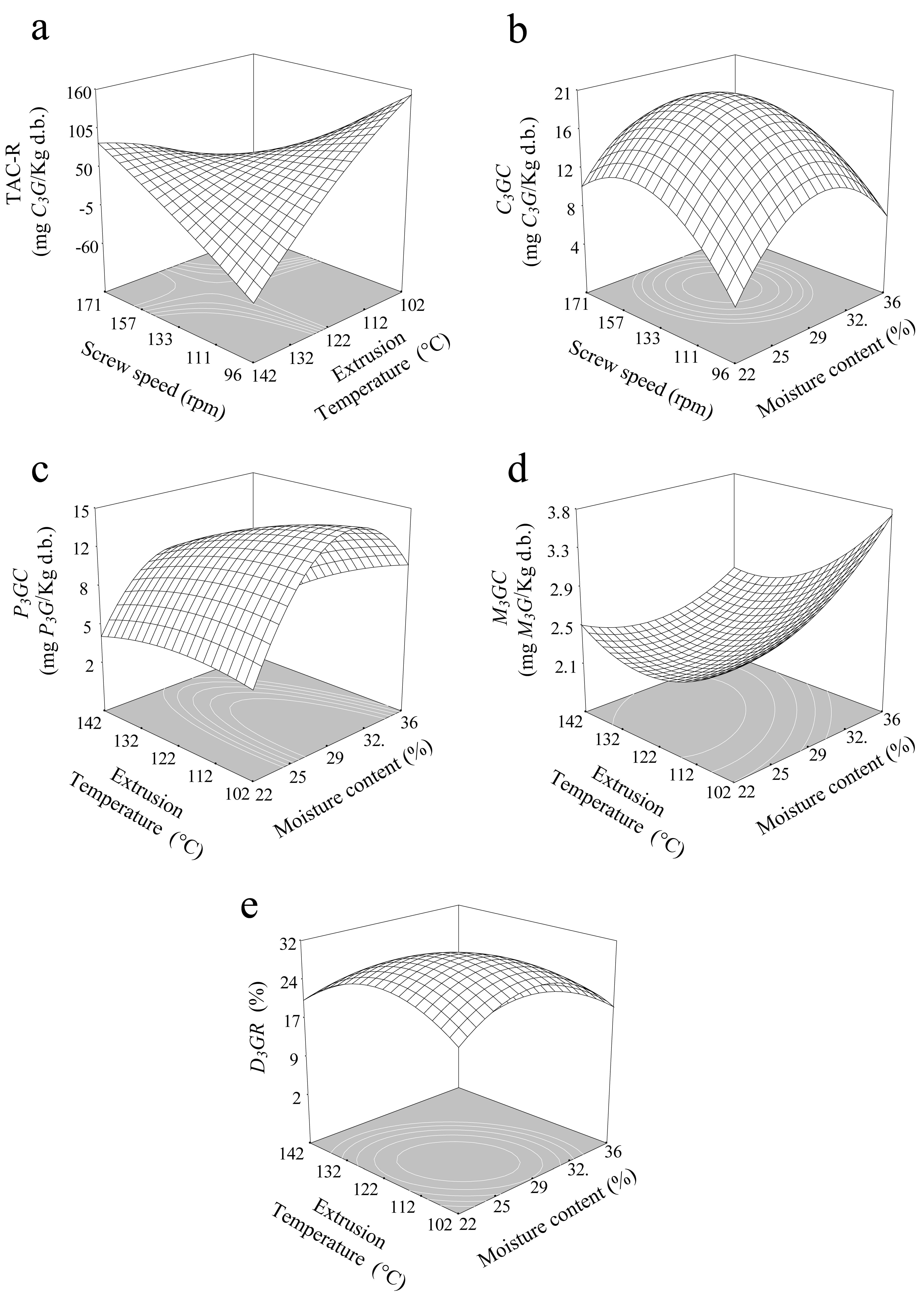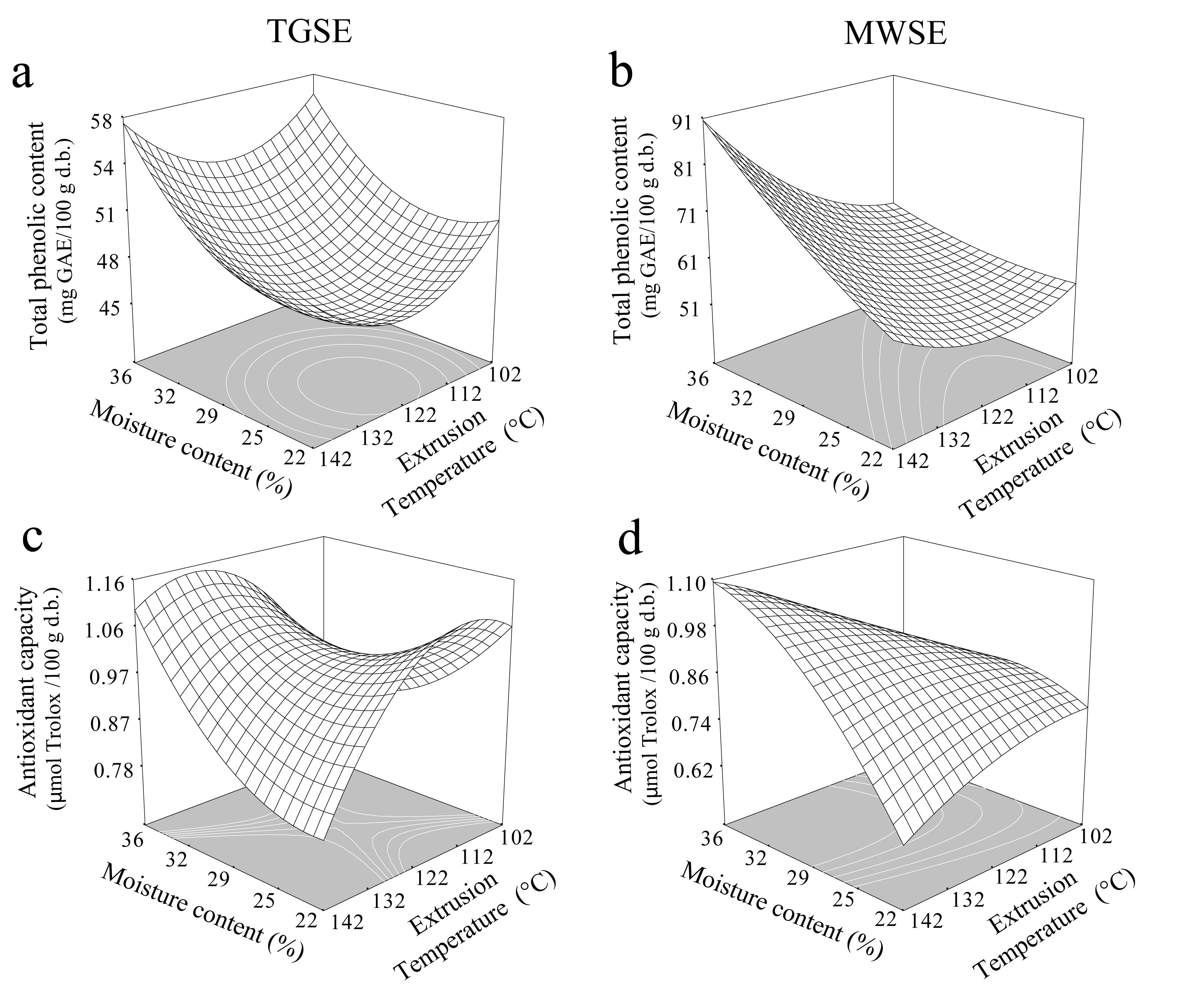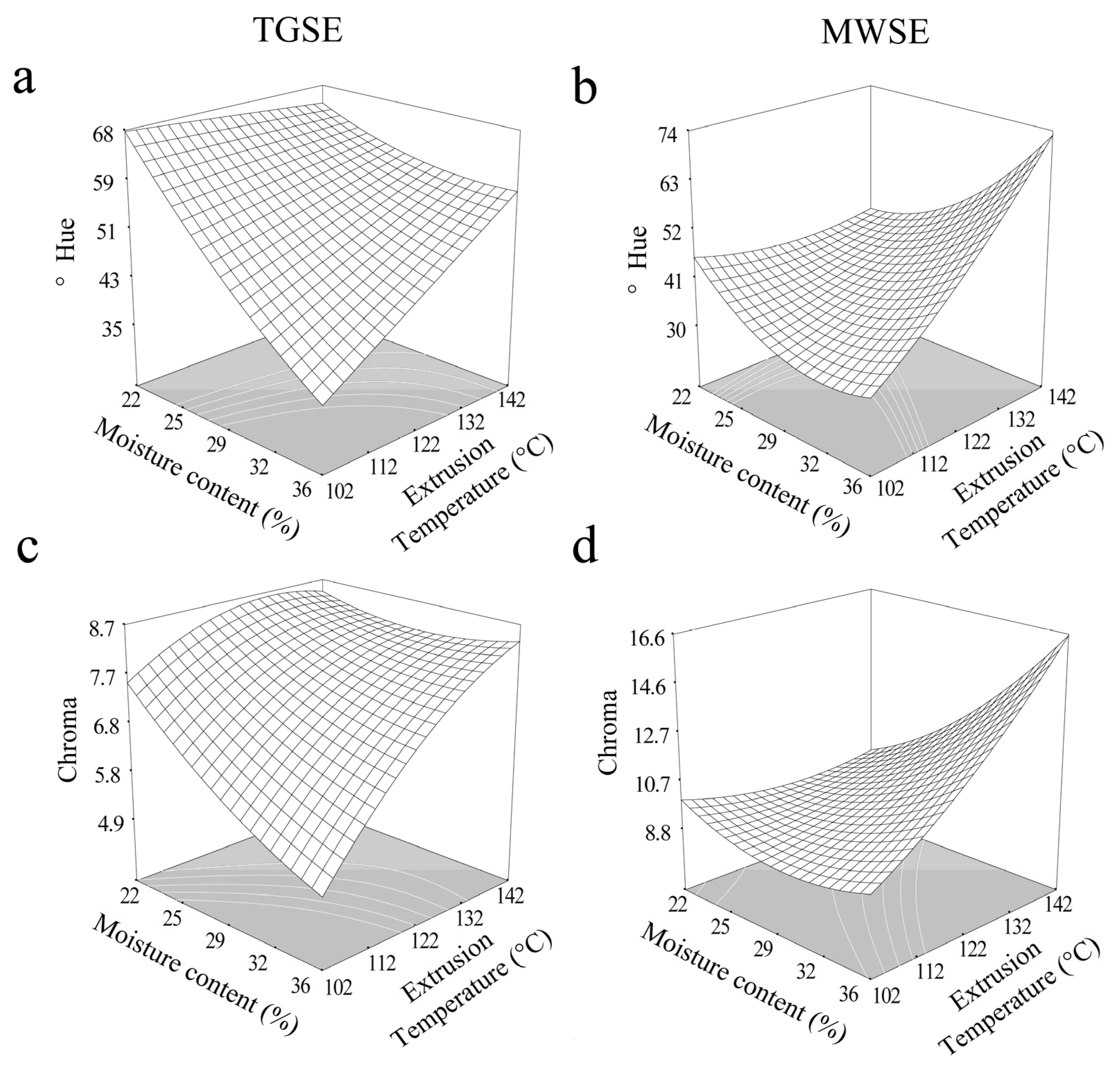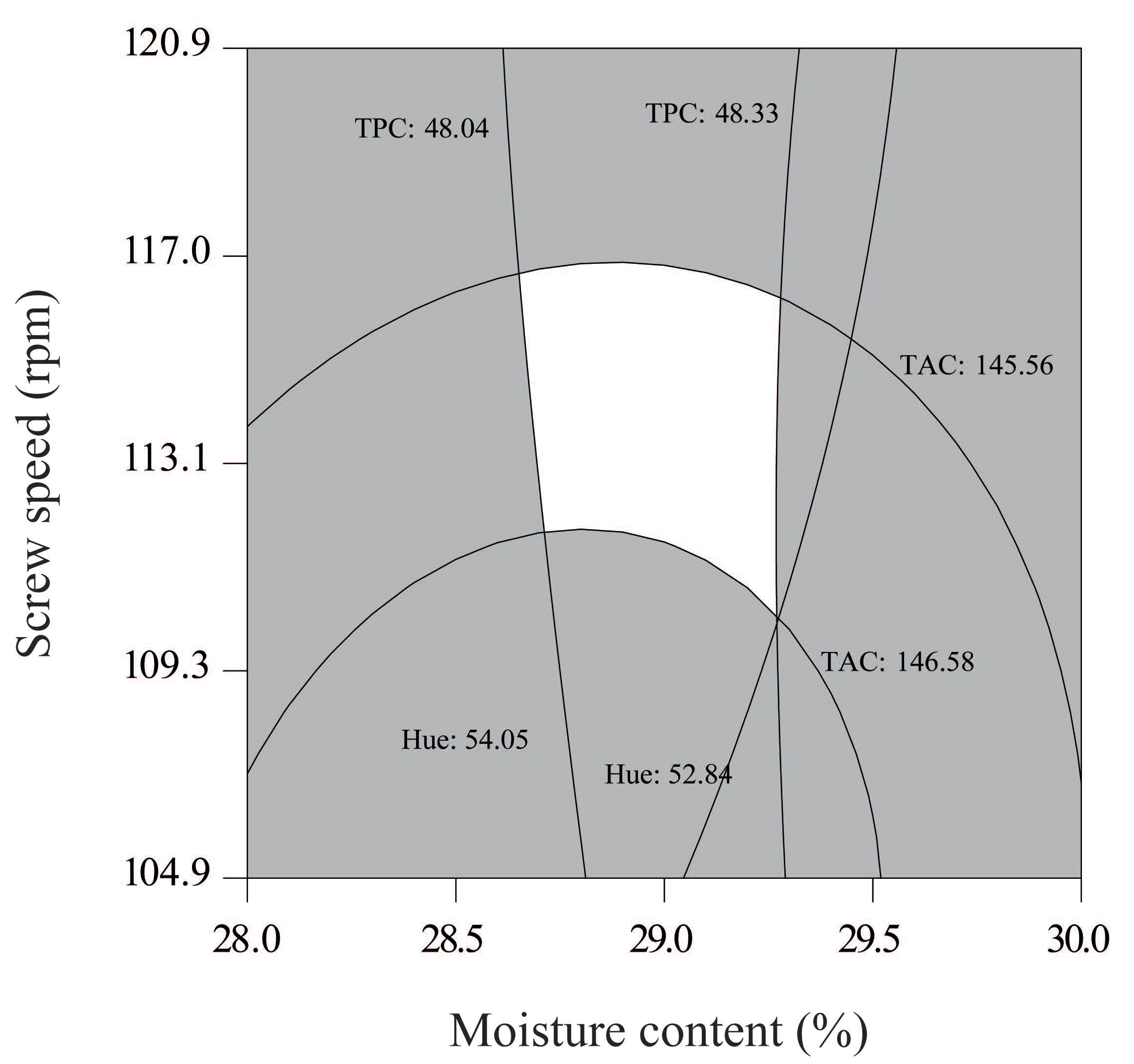Anthocyanins and Functional Compounds Change in a Third-Generation Snacks Prepared Using Extruded Blue Maize, Black Bean, and Chard: An Optimization
Abstract
:1. Introduction
2. Materials and Methods
2.1. Raw Material
2.2. Preparation for Mixture Extrusion
2.3. Extrusion Cooking
2.4. Microwave Expansion
2.5. Preparation of 3G Snack Extracts
2.6. Profiles of Total and Individual Anthocyanins
2.7. Total Phenolic Content (TPC)
2.8. Antioxidant Activity (AA)
2.9. Color Parameters
2.10. Experimental Design and Statistical Analysis
3. Results and Discussion
3.1. Model Fitting
3.2. Individual Anthocyanins
3.3. Total Phenolic Content (TPC) and Antioxidant Activity (AA)
3.4. Color Parameters
3.5. Optimal Conditions
3.6. Process Validation
4. Conclusions
Author Contributions
Funding
Institutional Review Board Statement
Informed Consent Statement
Data Availability Statement
Acknowledgments
Conflicts of Interest
References
- Escalante-Aburto, A.; Ponce-García, N.; Ramírez-Wong, B.; Torres-Chávez, P.I.; Figueroa-Cárdenas, J.D.D.; Dorado, R.G. Specific Anthocyanin Contents of Whole Blue Maize Second-Generation Snacks: An Evaluation Using Response Surface Methodology and Lime Cooking Extrusion. J. Chem. 2016, 2016, 5491693. [Google Scholar] [CrossRef] [Green Version]
- Menchaca-Armenta, M.; Ramírez-Wong, B.; Torres-Chávez, P.I.; Quintero-Ramos, A.; Ledesma-Osuna, A.I.; Frutos, M.J.; Gutiérrez-Dorado, R.; Campas-Baypoli, O.N.; Morales-Rosas, I. Effect of extrusion conditions on the anthocyanin content, functionality, and pasting properties of obtained nixtamalized blue corn flour (Zea mays L.) and process optimization. J. Food Sci. 2020, 85, 2143–2152. [Google Scholar] [CrossRef]
- Mojica, L.; Berhow, M.; de Mejia, E.G. Black bean anthocyanin-rich extracts as food colorants: Physicochemical stability and antidiabetes potential. Food Chem. 2017, 229, 628–639. [Google Scholar] [CrossRef] [PubMed]
- Mora-Rochín, S.; Gaxiola-Cuevas, N.; Gutiérrez-Uribe, J.A.; Carrillo, J.M.; Milán-Noris, E.M.; Reyes-Moreno, C.; Serna-Saldívar, S.O.; Cuevas-Rodriguez, E.O. Effect of traditional nixtamalization on anthocyanin content and profile in Mexican blue maize (Zea mays L.) landraces. LWT 2016, 68, 563–569. [Google Scholar] [CrossRef]
- Damián-Medina, K.; Salinas-Moreno, Y.; Milenkovic, D.; Figueroa-Yáñez, L.; Marino-Marmolejo, E.; Higuera-Ciapara, I.; Vallejo-Cardona, A.; Lugo-Cervantes, E. In silico analysis of antidiabetic potential of phenolic compounds from blue corn (Zea mays L.) and black bean (Phaseolus vulgaris L.). Heliyon 2020, 6, e03632. [Google Scholar] [CrossRef] [PubMed]
- Brennan, C.; Brennan, M.; Derbyshire, E.; Tiwari, B.K. Effects of extrusion on the polyphenols, vitamins and antioxidant activity of foods. Trends Food Sci. Technol. 2011, 22, 570–575. [Google Scholar] [CrossRef]
- Smorowska, A.J.; Żołnierczyk, A.K.; Nawirska-Olszańska, A.; Sowiński, J.; Szumny, A. Nutritional Properties and In Vitro Antidiabetic Activities of Blue and Yellow Corn Extracts: A Comparative Study. J. Food Qual. 2021, 2021. [Google Scholar] [CrossRef]
- Herrera-Sotero, M.Y.; Cruz-Hernández, C.D.; Oliart-Ros, R.M.; Chávez-Servia, J.L.; Guzmán-Gerónimo, R.I.; González-Covarrubias, V.; Cruz-Burgos, M.; Rodríguez-Dorantes, M. Anthocyanins of Blue Corn and Tortilla Arrest Cell Cycle and Induce Apoptosis on Breast and Prostate Cancer Cells. Nutr. Cancer 2019, 72, 768–777. [Google Scholar] [CrossRef] [PubMed]
- Pyo, Y.-H.; Lee, T.-C.; Logendra, L.; Rosen, R.T. Antioxidant activity and phenolic compounds of Swiss chard (Beta vulgaris subspecies cycla) extracts. Food Chem. 2004, 85, 19–26. [Google Scholar] [CrossRef]
- Gamba, M.; Raguindin, P.F.; Asllanaj, E.; Merlo, F.; Glisic, M.; Minder, B.; Bussler, W.; Metzger, B.; Kern, H.; Muka, T. Bioactive compounds and nutritional composition of Swiss chard (Beta vulgaris L. var. cicla and flavescens): A systematic review. Crit. Rev. Food Sci. Nutr. 2020. [Google Scholar] [CrossRef]
- Fernández-López, J.; Botella-Martínez, C.; De Vera, C.N.-R.; Sayas-Barberá, M.E.; Viuda-Martos, M.; Sánchez-Zapata, E.; Pérez-Álvarez, J.A. Vegetable Soups and Creams: Raw Materials, Processing, Health Benefits, and Innovation Trends. Plants 2020, 9, 1769. [Google Scholar] [CrossRef]
- Camacho-Hernández, I.; Zazueta-Morales, J.; Gallegos-Infante, J.; Aguilar-Palazuelos, E.; Guzmán, N.E.R.; Cortez, R.O.N.; Jacobo-Valenzuela, N.; Gomez-Aldapa, C. Effect of extrusion conditions on physicochemical characteristics and anthocyanin content of blue corn third-generation snacks. CyTA-J. Food 2014, 12, 320–330. [Google Scholar] [CrossRef]
- Escalante-Aburto, A.; Ramírez-Wong, B.; Torres-Chávez, P.I.; López-Cervantes, J.; Figueroa-Cárdenas, J.D.D.; Barrón-Hoyos, J.M.; Morales-Rosas, I.; Ponce-García, N.; Gutiérrez-Dorado, R. Obtaining Ready-to-Eat Blue Corn Expanded Snacks with Anthocyanins Using an Extrusion Process and Response Surface Methodology. Molecules 2014, 19, 21066–21084. [Google Scholar] [CrossRef] [PubMed]
- Pérez-Navarrete, C.; Cruz-Estrada, R.H.; Chel-Guerrero, L.; Betancur-Ancona, D. Caracterización física de extrudidos preparados con mezclas de harinas de maíz QPM (Zea mays L.) y fríjol lima (Phaseolus lunatus L.). Rev. Mex. Ing. Quim. 2006, 5, 145–155. [Google Scholar]
- Schmid, V.; Steck, J.; Mayer-Miebach, E.; Behsnilian, D.; Bunzel, M.; Karbstein, H.; Emin, M. Extrusion Processing of Pure Chokeberry (Aronia melanocarpa) Pomace: Impact on Dietary Fiber Profile and Bioactive Compounds. Foods 2021, 10, 518. [Google Scholar] [CrossRef] [PubMed]
- Zhang, R.; Khan, S.A.; Chi, J.; Wei, Z.; Zhang, Y.; Deng, Y.; Liu, L.; Zhang, M. Different effects of extrusion on the phenolic profiles and antioxidant activity in milled fractions of brown rice. LWT 2018, 88, 64–70. [Google Scholar] [CrossRef]
- Serna-Saldivar, S.O.; Chuck-Hernandez, C. Food Uses of Lime-Cooked Corn with Emphasis in Tortillas and Snacks. In Corn; Elsevier BV: Amsterdam, The Netherlands, 2018; pp. 469–500. [Google Scholar]
- Colombo, R.; Ferron, L.; Papetti, A. Colored Corn: An Up-Date on Metabolites Extraction, Health Implication, and Potential Use. Molecules 2021, 26, 199. [Google Scholar] [CrossRef] [PubMed]
- Francavilla, A.; Joye, I.J. Anthocyanins in Whole Grain Cereals and Their Potential Effect on Health. Nutrients 2020, 12, 2922. [Google Scholar] [CrossRef]
- Luna-Vital, D.A.; Li, Q.; West, L.; West, M.; de Mejia, E.G. Anthocyanin condensed forms do not affect color or chemical stability of purple corn pericarp extracts stored under different pHs. Food Chem. 2017, 232, 639–647. [Google Scholar] [CrossRef]
- Patras, A.; Brunton, N.; O’Donnell, C.; Tiwari, B. Effect of thermal processing on anthocyanin stability in foods; mechanisms and kinetics of degradation. Trends Food Sci. Technol. 2010, 21, 3–11. [Google Scholar] [CrossRef]
- Qin, X.; Yuan, D.; Wang, Q.; Hu, Z.; Wu, Y.; Cai, J.; Huang, Q.; Li, S.; Liu, G. Maillard-Reacted Whey Protein Isolates Enhance Thermal Stability of Anthocyanins over a Wide pH Range. J. Agric. Food Chem. 2018, 66, 9556–9564. [Google Scholar] [CrossRef]
- Wu, H.-Y.; Yang, K.-M.; Chiang, P.-Y. Roselle Anthocyanins: Antioxidant Properties and Stability to Heat and pH. Molecules 2018, 23, 1357. [Google Scholar] [CrossRef] [Green Version]
- Hong, H.; Netzel, M.; O’Hare, T. Optimisation of extraction procedure and development of LC–DAD–MS methodology for anthocyanin analysis in anthocyanin-pigmented corn kernels. Food Chem. 2020, 319, 126515. [Google Scholar] [CrossRef] [PubMed]
- Rabanal-Atalaya, M.; Medina-Hoyos, A. Análisis de antocianinas en el maíz morado (Zea mays L.) del Perú y sus propiedades antioxidantes. Rev. Terra Latinoam. 2021, 39. [Google Scholar] [CrossRef]
- Ursu, M.; Aprodu, I.; Milea, Ș.; Enachi, E.; Râpeanu, G.; Bahrim, G.; Stănciuc, N. Thermal Degradation Kinetics of Anthocyanins Extracted from Purple Maize Flour Extract and the Effect of Heating on Selected Biological Functionality. Foods 2020, 9, 1593. [Google Scholar] [CrossRef]
- Delgado-Nieblas, C.; Ruiz-Beltrán, K.; Sánchez-Lizárraga, J.; Zazueta-Morales, J.D.J.; Aguilar-Palazuelos, E.; Carrillo-López, A.; Camacho-Hernández, I.L.; Quintero-Ramos, A. Effect of extrusion on physicochemical, nutritional and antioxidant properties of breakfast cereals produced from bran and dehydrated naranjita pomace. CyTA-J. Food 2019, 17, 240–250. [Google Scholar] [CrossRef]
- Ruiz-Armenta, X.A.; Zazueta-Morales, J.D.J.; Delgado-Nieblas, C.I.; Carrillo-López, A.; Aguilar-Palazuelos, E.; Camacho-Hernández, I.L. Effect of the extrusion process and expansion by microwave heating on physicochemical, phytochemical, and antioxidant properties during the production of indirectly expanded snack foods. J. Food Process. Preserv. 2019, 43, 14261. [Google Scholar] [CrossRef]
- Sun, Y.; Zhang, Y.; Xu, W.; Zheng, X. Analysis of the Anthocyanin Degradation in Blue Honeysuckle Berry under Microwave Assisted Foam-Mat Drying. Foods 2020, 9, 397. [Google Scholar] [CrossRef] [Green Version]
- Jacques-Fajardo, G.E.; Prado-Ramírez, R.; Arriola-Guevara, E.; Carrillo, E.P.; Espinosa-Andrews, H.; Morales, G.M.G. Physical and hydration properties of expanded extrudates from a blue corn, yellow pea and oat bran blend. LWT 2017, 84, 804–814. [Google Scholar] [CrossRef]
- Leyva-Corral, J.; Quintero-Ramos, A.; Camacho-Dávila, A.; Zazueta-Morales, J.D.J.; Aguilar-Palazuelos, E.; Ruiz-Gutiérrez, M.G.; Meléndez-Pizarro, C.O.; Ruiz-Anchondo, T.D.J. Polyphenolic compound stability and antioxidant capacity of apple pomace in an extruded cereal. LWT 2016, 65, 228–236. [Google Scholar] [CrossRef]
- Escalante-Aburto, A.; Ramirez-Wong, B.; Torres-Chávez, P.; Figueroa-Cárdenas, J.; López-Cervantes, J.; Barrón-Hoyos, J.; Morales-Rosas, I. Effect of extrusion processing parameters on anthocyanin content and physicochemical properties of nixtamalized blue corn expanded extrudates. CyTA-J. Food 2013, 11, 29–37. [Google Scholar] [CrossRef]
- Gomez-Aldapa, C.; Navarro-Cortez, R.; Aguilar-Palazuelos, E.; Zazueta-Morales, J.; Rosas, J.C.; Hernandez-Ávila, J.; Aguirre-Tostado, F. Microstructure of an Extruded Third-Generation Snack Made from a Whole Blue Corn and Corn Starch Mixture. Int. J. Food Process. Technol. 2014, 1, 10–17. [Google Scholar] [CrossRef]
- Neder-Suárez, D.; Quintero-Ramos, A.; Meléndez-Pizarro, C.O.; Zazueta-Morales, J.D.J.; Paraguay-Delgado, F.; Ruiz-Gutiérrez, M.G. Evaluation of the physicochemical properties of third-generation snacks made from blue corn, black beans, and sweet chard produced by extrusion. LWT 2021, 146, 111414. [Google Scholar] [CrossRef]
- Sánchez-Madrigal, M.Á.; Quintero-Ramos, A.; Amaya-Guerra, C.A.; Meléndez-Pizarro, C.O.; Castillo-Hernández, S.L.; Aguilera-González, C.J. Effect of Agave Fructans as Carrier on the Encapsulation of Blue Corn Anthocyanins by Spray Drying. Foods 2019, 8, 268. [Google Scholar] [CrossRef] [Green Version]
- Nayak, B.; Berrios, J.D.J.; Powers, J.R.; Tang, J. Effect of Extrusion on the Antioxidant Capacity and Color Attributes of Expanded Extrudates Prepared from Purple Potato and Yellow Pea Flour Mixes. J. Food Sci. 2011, 76, C874–C883. [Google Scholar] [CrossRef]
- Zhao, M.; Luo, Y.; Li, Y.; Liu, X.; Wu, J.; Liao, X.; Chen, F. The identification of degradation products and degradation pathway of malvidin-3-glucoside and malvidin-3,5-diglucoside under microwave treatment. Food Chem. 2013, 141, 3260–3267. [Google Scholar] [CrossRef] [PubMed]
- Yue, X.; Xu, Z. Changes of Anthocyanins, Anthocyanidins, and Antioxidant Activity in Bilberry Extract during Dry Heating. J. Food Sci. 2008, 73, C494–C499. [Google Scholar] [CrossRef] [PubMed]
- Xu, B.; Chang, S.K.C. Total Phenolic, Phenolic Acid, Anthocyanin, Flavan-3-ol, and Flavonol Profiles and Antioxidant Properties of Pinto and Black Beans (Phaseolus vulgaris L.) as Affected by Thermal Processing. J. Agric. Food Chem. 2009, 57, 4754–4764. [Google Scholar] [CrossRef] [PubMed]
- Teixeira, R.F.; Benvenutti, L.; Burin, V.M.; Gomes, T.M.; Ferreira, S.R.S.; Zielinski, A.A.F. An eco-friendly pressure liquid extraction method to recover anthocyanins from broken black bean hulls. Innov. Food Sci. Emerg. Technol. 2021, 67, 102587. [Google Scholar] [CrossRef]
- Wang, X.; Hansen, C.; Allen, K. Identification of Anthocyanins Isolated from Black Bean Canning Wastewater by Macroporous Resin Using Optimized Conditions. Food Nutr. Sci. 2013, 4, 174–181. [Google Scholar] [CrossRef]
- Ti, H.; Zhang, R.; Zhang, M.; Wei, Z.; Chi, J.; Deng, Y.; Zhang, Y. Effect of extrusion on phytochemical profiles in milled fractions of black rice. Food Chem. 2015, 178, 186–194. [Google Scholar] [CrossRef] [PubMed]
- White, B.L.; Howard, L.R.; Prior, R.L. Polyphenolic Composition and Antioxidant Capacity of Extruded Cranberry Pomace. J. Agric. Food Chem. 2010, 58, 4037–4042. [Google Scholar] [CrossRef] [PubMed]
- Del Pozo-Insfran, D.; Saldivar, S.O.S.; Brenes, C.H.; Talcott, S.T. Polyphenolics and Antioxidant Capacity of White and Blue Corns Processed into Tortillas and Chips. Cereal Chem. J. 2007, 84, 162–168. [Google Scholar] [CrossRef]





| Coded Levels | Process Variables | |||||
|---|---|---|---|---|---|---|
| Treatment | X1 | X2 | X3 | MC (%) | SP (rpm) | ET (°C) |
| 1 | −1 | −1 | −1 | 25 | 111 | 110 |
| 2 | 1 | −1 | −1 | 33 | 111 | 110 |
| 3 | −1 | 1 | −1 | 25 | 157 | 110 |
| 4 | 1 | 1 | −1 | 33 | 157 | 110 |
| 5 | −1 | −1 | 1 | 25 | 111 | 134 |
| 6 | 1 | −1 | 1 | 33 | 111 | 134 |
| 7 | −1 | 1 | 1 | 25 | 157 | 134 |
| 8 | 1 | 1 | 1 | 33 | 157 | 134 |
| 9 | −1.68 | 0 | 0 | 22.2 | 133 | 122 |
| 10 | 1.68 | 0 | 0 | 35.7 | 133 | 122 |
| 11 | 0 | −1.68 | 0 | 29 | 96 | 122 |
| 12 | 0 | 1.68 | 0 | 29 | 171 | 122 |
| 13 | 0 | 0 | −1.68 | 29 | 133 | 102 |
| 14 | 0 | 0 | 1.68 | 29 | 133 | 142 |
| 15 | 0 | 0 | 0 | 29 | 133 | 122 |
| 16 | 0 | 0 | 0 | 29 | 133 | 122 |
| 17 | 0 | 0 | 0 | 29 | 133 | 122 |
| 18 | 0 | 0 | 0 | 29 | 133 | 122 |
| 19 | 0 | 0 | 0 | 29 | 133 | 122 |
| 20 | 0 | 0 | 0 | 29 | 133 | 122 |
| Coefficient | TGSE | |||||||||
|---|---|---|---|---|---|---|---|---|---|---|
| TAC | C3GC | P3GC | P3-5DGC | M3GC | D3GR | TPC | AA | Hue | Chroma | |
| Intercept | 137.39 | 22.23 | 52.68 | 45.66 | 4.96 | 52.68 | 45.91 | 1.17 | 54.22 | 7.57 |
| b1 | 0.63 | −0.65 | −0.81 | −0.88 | −0.20 | −0.81 | 1.85 ** | < 0.01 | −5.62 ** | −0.38 ** |
| b2 | −8.32 * | −0.92 | −2.41 | −4.14 | −0.53 ** | −2.41 | −0.99 | < 0.01 | −0.02 | 0.11 |
| b3 | −9.83 * | −0.59 | −5.29 * | −5.26 * | −0.51 ** | −5.29 ** | −0.02 | −0.01 | 2.95 ** | 0.64 ** |
| b12 | 2.47 | −0.15 | 1.59 | 3.31 | 0.08 | 1.59 | 1.39 | −0.02 | −0.77 | 0.06 |
| b13 | −1.73 | −1.11 | −1.32 | 2.76 | 0.04 | −1.32 | 0.21 | 0.05 * | 2.20 * | 0.22 |
| b23 | 26.06 ** | 3.16 ** | 8.34 ** | 11.10 ** | 0.95 ** | 8.34 ** | 1.34 | −0.03 | 1.83 | 0.21 |
| b11 | −13.55 ** | −1.23 * | −7.18 * | −2.87 | −0.32 ** | −7.18 ** | 1.28 * | 0.08 * | 0.75 | 0.09 |
| b22 | −4.81 | −0.14 | −2.96 | −0.37 | 0.20 | −2.96 | 1.00 | −0.01 | −0.79 | −0.15 |
| b33 | −6.94 | −0.60 | −3.09 | −1.80 | −0.08 | −3.09 | 1.46 * | −0.05 ** | −0.01 | −0.18 |
| p−Value (model) | <0.01 | 0.01 | <0.01 | 0.04 | <0.01 | <0.01 | 0.02 | 0.04 | <0.01 | <0.01 |
| Lack to fit | 0.01 | 0.65 | 0.19 | 0.11 | 0.73 | 0.48 | 0.56 | 0.58 | 0.10 | 0.07 |
| CV | 10.94 | 20.89 | 19.69 | 19.59 | 9.23 | 14.17 | 4.40 | 5.78 | 3.87 | 5.40 |
| R2 | 0.86 | 0.79 | 0.83 | 0.73 | 0.89 | 0.83 | 0.76 | 0.74 | 0.93 | 0.85 |
| Coefficient | MWSE | ||||||||
|---|---|---|---|---|---|---|---|---|---|
| TAC−R | C3GC | P3GC | M3GC | D3GR | TPC | AA | Hue | Chroma | |
| Intercept | 58.99 | 20.05 | 13.26 | 2.30 | 29.85 | 57.94 | 1.07 | 38.90 | 9.92 |
| b1 | 3.10 | 0.12 | 0.53 | −0.16 | −2.94 ** | 5.26 ** | 0.86 ** | 2.24 ** | 0.93 ** |
| b2 | −7.71 | 0.56 | 0.11 | −0.31 * | 0.07 | 0.47 | −0.01 | < 0.01 | 0.13 |
| b3 | −7.68 | 0.39 | −0.27 * | −0.29 * | −2.72 ** | 4.69 ** | 0.02 * | 5.79 ** | 0.98 ** |
| b12 | 3.14 | −0.36 | −0.63 | −0.08 | −1.01 | −0.42 | 0.01 | −0.62 | 0.17 |
| b13 | 1.44 | −0.46 | −0.61 | −0.33 * | −1.35 | 2.35 | 0.05 ** | 3.69 ** | 0.66 ** |
| b23 | 26.89 ** | −0.40 | −0.98 | 0.22 | 1.22 | 2.09 | 0.01 | 0.64 | 0.16 |
| b11 | −8.00 | −2.25 ** | −2.22 ** | 0.19 | −2.39 * | 0.76 | −0.03 ** | 2.31 ** | 0.29 ** |
| b22 | −1.68 | −1.57 ** | −0.41 | 0.35 ** | −0.72 | −0.35 | −0.02 | −0.70 | −0.10 |
| b33 | −6.23 | <−0.01 | −0.33 | 0.27 * | −2.28 * | 2.22 | −0.01 | 0.98 * | 0.20 * |
| p−Value (model) | 0.01 | 0.01 | 0.02 | 0.01 | 0.01 | 0.01 | <0.01 | <0.01 | <0.01 |
| Lack to fit | 0.06 | 0.11 | 0.43 | <0.01 | 0.57 | <0.01 | 0.03 | 0.16 | 0.02 |
| CV | 30.67 | 9.72 | 15.68 | 14.07 | 11.99 | 7.54 | 4.94 | 3.91 | 3.03 |
| R2 | 0.80 | 0.79 | 0.78 | 0.81 | 0.80 | 0.80 | 0.90 | 0.96 | 0.97 |
| Material | TAC | C3GC | P3GC | M3GC | P3-5DGC | TPC | AA | Hue |
|---|---|---|---|---|---|---|---|---|
| Blue corn | 357.92 ± 12.48 | 77.72 ± 1.17 | 11.47 ± 0.61 | 21.85 ± 0.41 | nd | 126.49 ± 1.35 | 2.74 ± 0.04 | 338.8 ± 0.15° |
| Black bean | 239.78 ± 4.11 | 16.44 ± 1.74 | 67.74 ± 1.62 | 7.45 ± 0.27 | 62.64 ± 0.84 | 68.32 ± 0.66 | 2.63 ± 0.01 | 85.12 ± 0.31° |
| Chard | nq | nq | nq | nq | nq | 1979.01 ± 33.86 | 12.88 ± 0.09 | 16.42 ± 0.78° |
| FBCS | 310.90 ± 7.16 | 43.50 ± 1.56 | 35.46 ± 0.96 | 13.32 ± 0.54 | 46.50 ± 1.31 | 149.73 ± 0.33 | 3.25 ± 0.01 | 290.78 ± 0.14° |
| Experimental | Estimated | % Error | |
|---|---|---|---|
| TAC | 160.41 ± 3.06 | 146.69 | 9.35 |
| C3GC | 27.48 ± 0.86 | 23.60 | 16.48 |
| P3GC | 21.27 ± 0.36 | 24.26 | 12.32 |
| P3-5DGC | 59.95 ± 0.77 | 52.04 | 15.19 |
| M3GC | 6.74 ± 0.89 | 5.90 | 14.23 |
| D3GR | 60.03 ± 1.36 | 54.36 | 10.43 |
| TPC | 43.27 ± 0.52 | 48.17 | 10.67 |
| Hue | 46.84 ± 1.14 | 53.32 | 12.83 |
Publisher’s Note: MDPI stays neutral with regard to jurisdictional claims in published maps and institutional affiliations. |
© 2021 by the authors. Licensee MDPI, Basel, Switzerland. This article is an open access article distributed under the terms and conditions of the Creative Commons Attribution (CC BY) license (https://creativecommons.org/licenses/by/4.0/).
Share and Cite
Neder-Suárez, D.; Lardizabal-Gutiérrez, D.; Zazueta-Morales, J.d.J.; Meléndez-Pizarro, C.O.; Delgado-Nieblas, C.I.; Ramírez Wong, B.; Gutiérrez-Méndez, N.; Hernández-Ochoa, L.R.; Quintero-Ramos, A. Anthocyanins and Functional Compounds Change in a Third-Generation Snacks Prepared Using Extruded Blue Maize, Black Bean, and Chard: An Optimization. Antioxidants 2021, 10, 1368. https://doi.org/10.3390/antiox10091368
Neder-Suárez D, Lardizabal-Gutiérrez D, Zazueta-Morales JdJ, Meléndez-Pizarro CO, Delgado-Nieblas CI, Ramírez Wong B, Gutiérrez-Méndez N, Hernández-Ochoa LR, Quintero-Ramos A. Anthocyanins and Functional Compounds Change in a Third-Generation Snacks Prepared Using Extruded Blue Maize, Black Bean, and Chard: An Optimization. Antioxidants. 2021; 10(9):1368. https://doi.org/10.3390/antiox10091368
Chicago/Turabian StyleNeder-Suárez, David, Daniel Lardizabal-Gutiérrez, José de Jesús Zazueta-Morales, Carmen Oralia Meléndez-Pizarro, Carlos Iván Delgado-Nieblas, Benjamín Ramírez Wong, Néstor Gutiérrez-Méndez, León Raúl Hernández-Ochoa, and Armando Quintero-Ramos. 2021. "Anthocyanins and Functional Compounds Change in a Third-Generation Snacks Prepared Using Extruded Blue Maize, Black Bean, and Chard: An Optimization" Antioxidants 10, no. 9: 1368. https://doi.org/10.3390/antiox10091368








